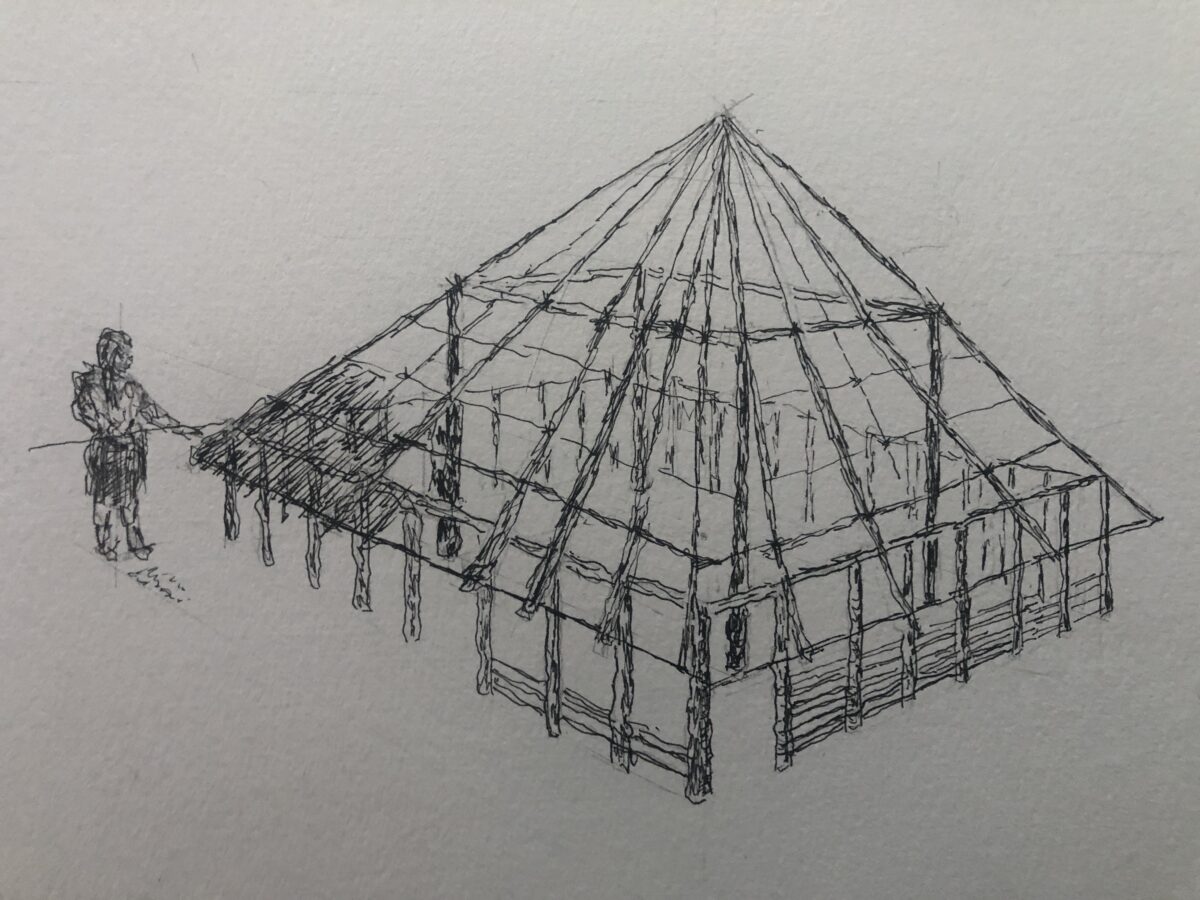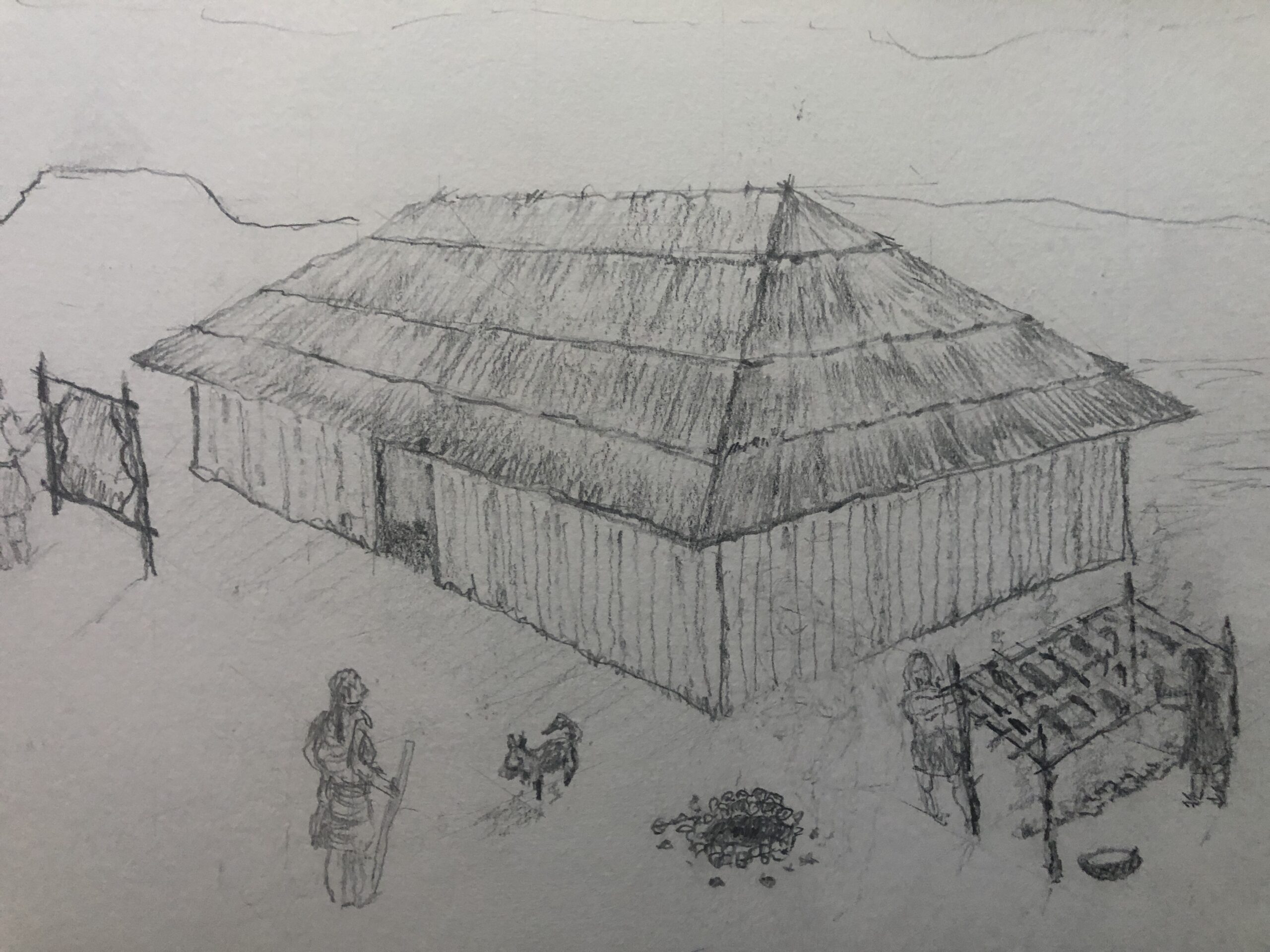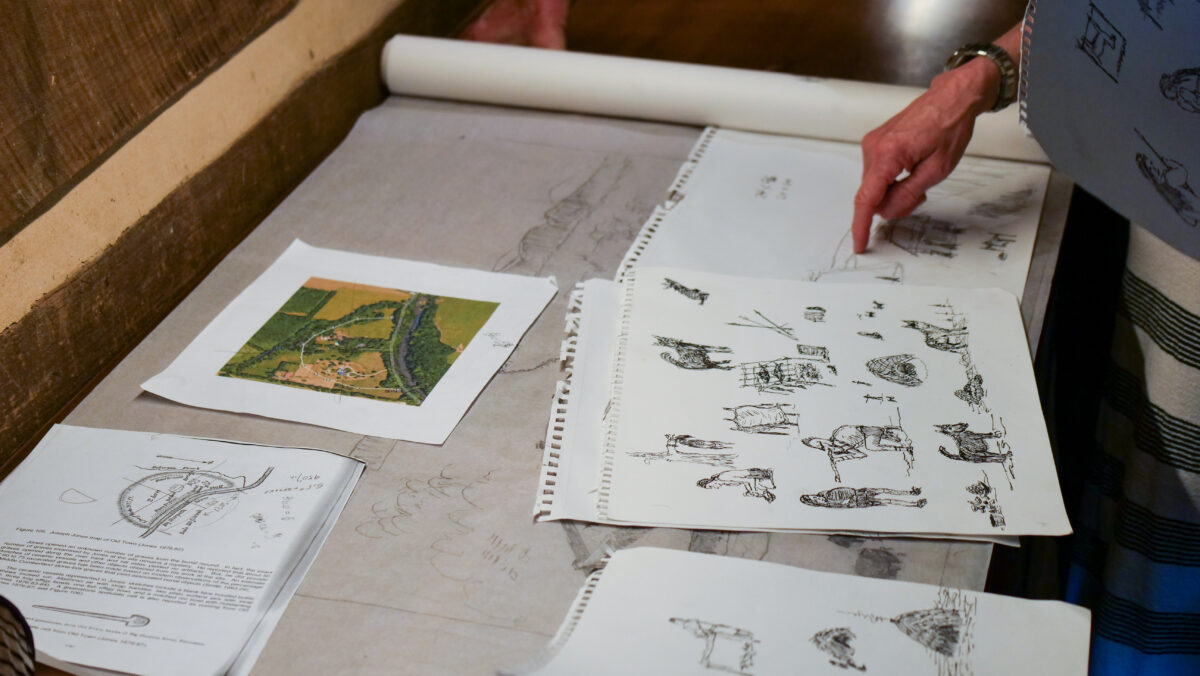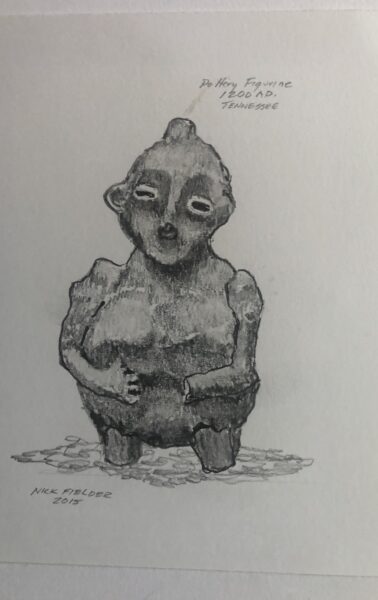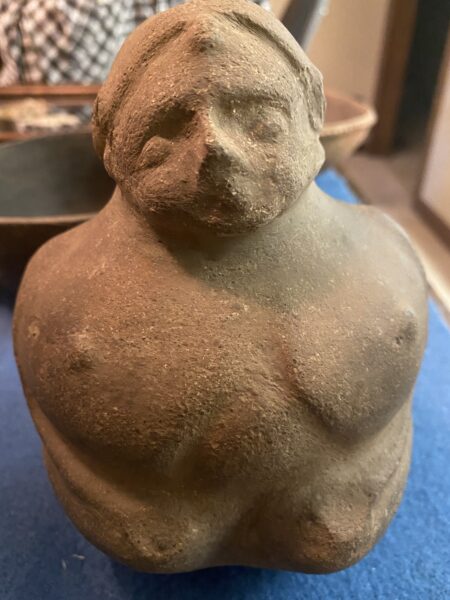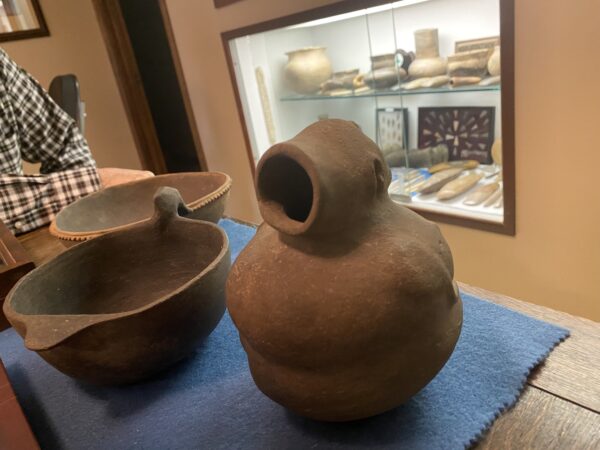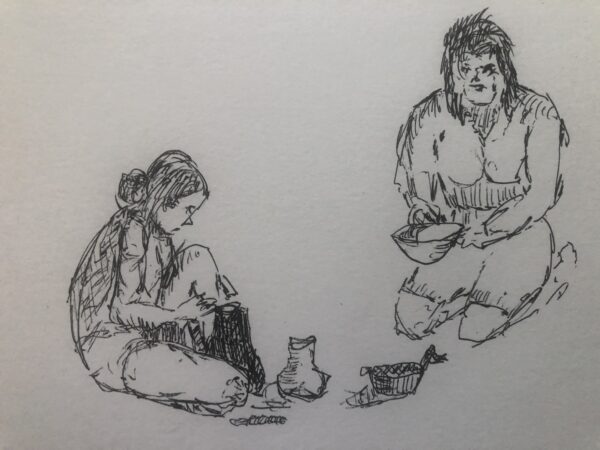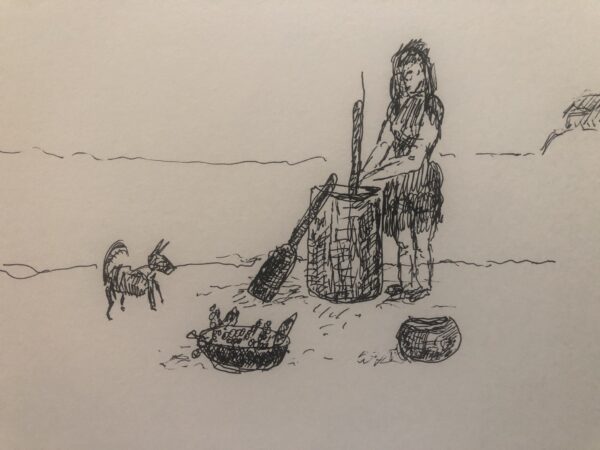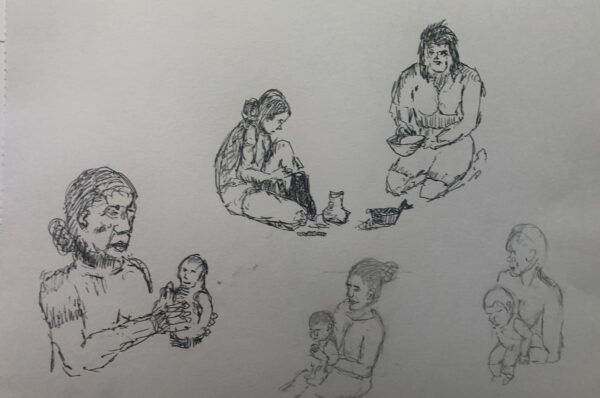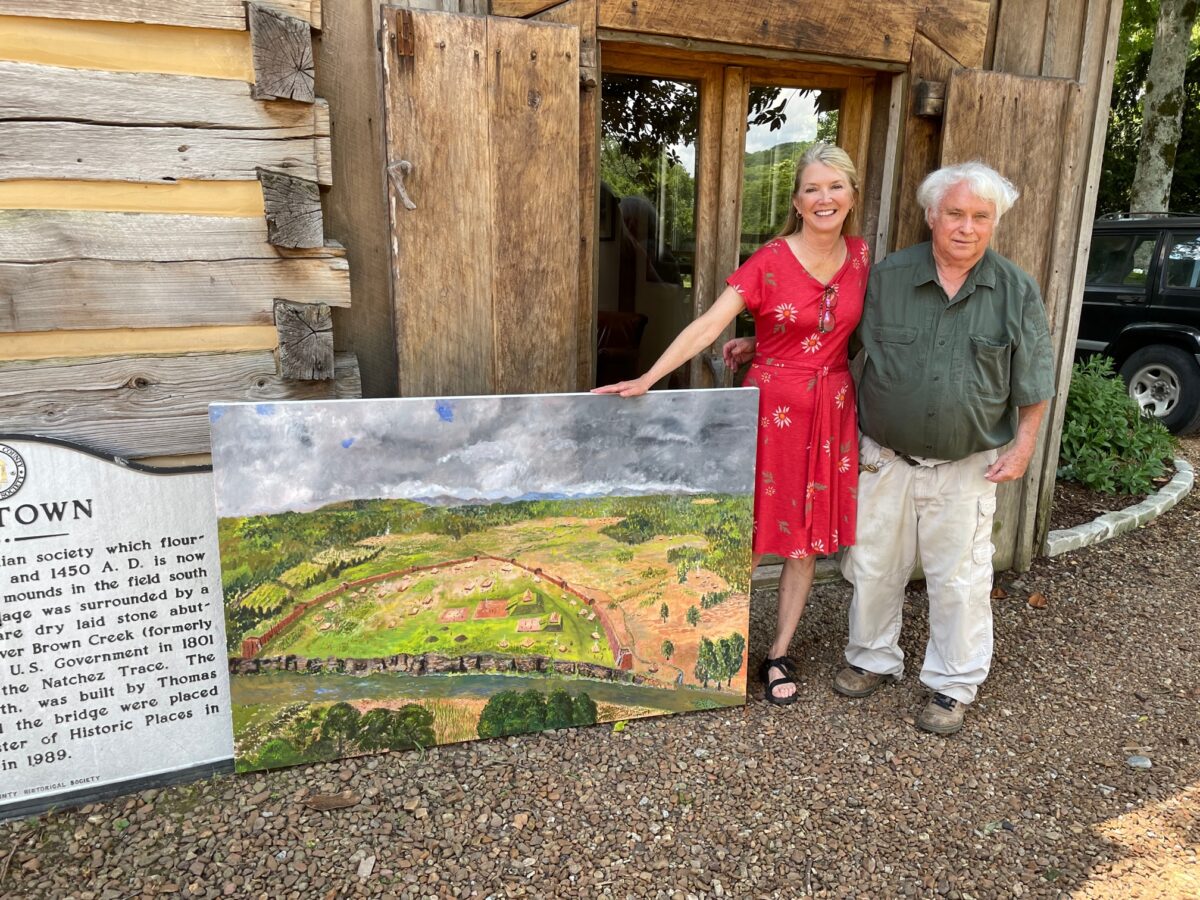
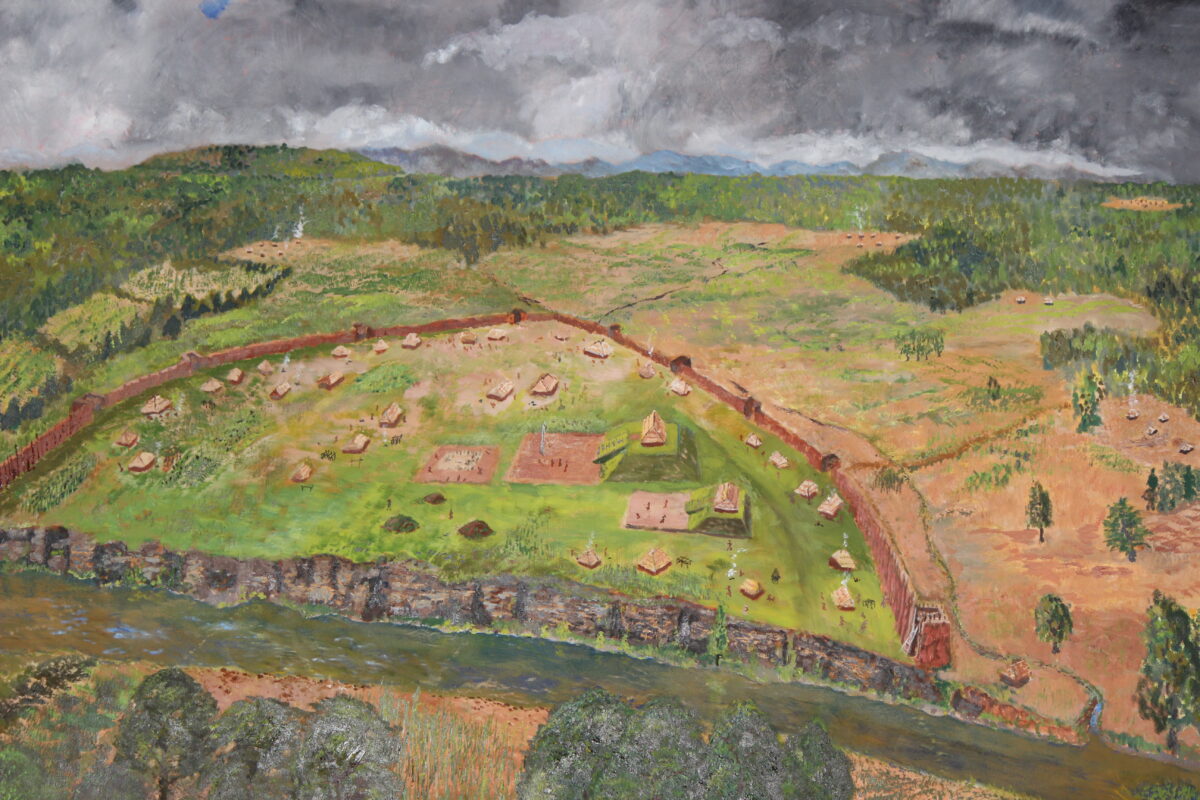
June 2022, Tracy Frist and Nick Fielder standing with Mr. Fielder’s painting of what Old Town would have looked like in the Ancient Era. Slide to see a closeup of the painting.
A thousand years ago, Williamson County was home to a thriving population of Native People living in a series of large towns, villages, hamlets and family farms. One of those towns was located here at Old Town – and the earthen pyramids, burial mounds, defensive earthworks, and other physical remains of that settlement indeed gave the location its traditional name “Old Town” early in the nineteenth century.
Located on the Harpeth River branch of the original Natchez Trace, this town (similar in some respects to a modern county seat) commanded a powerful position on that ancient overland route from Middle Tennessee to the Mississippi River. Eventually home to hundreds of families, Old Town was first occupied around AD 1050‐1200 and later abandoned by its residents by AD 1450-1475 (modern Franklin, Tennessee, probably reached a similar population to Old Town by about the mid‐1800s).
The center of government and religion for this part of the Big Harpeth River, the townspeople would have taken pride in their two large earthen pyramids (the temple mounds) – substructures for large temples and the palatial residence of the ruling family. Numerous public and religious buildings served a larger populace scattered in nearby smaller communities throughout the adjacent river valley. It was a sophisticated and highly structured society and was one of the most densely populated areas east of the Mississippi in the prehistoric era. The archaeological site at Old Town with the temple mounds is listed on the National Register of Historic Places.
Beginning in the AD 1300s and stretching into the 1400s, the Middle Tennessee region experienced a series of megadroughts ‐‐ documented through tree rings. Although the ingenuity of local peoples allowed them to survive several of these challenges, the resulting social and political turmoil that accompanied the long‐term health impacts of serial periodic famines eventually led to the outmigration of most of the populace to other parts of the southeast in the mid‐late 1400s.
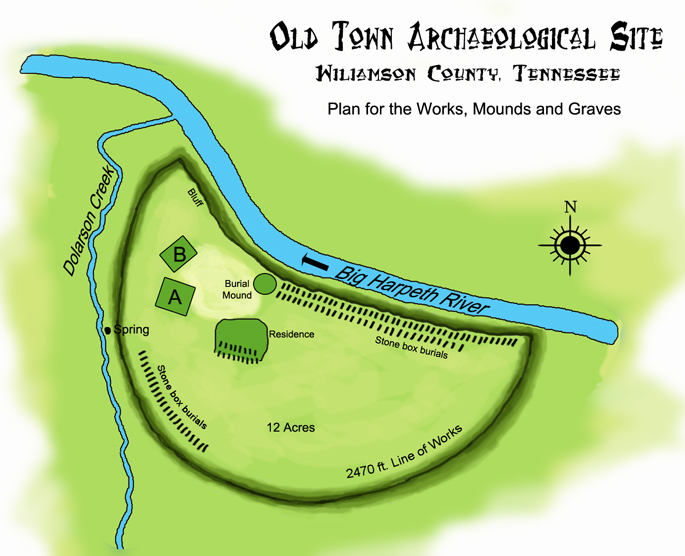
At its peak, the Mississippian tradition is characterized by the following: the construction of mounds for temples, elite residences, and council buildings; the arrangement of mounds and individual household structures around open plazas; increased population and more stable settlements; the emergence of organized chiefdoms; increased warfare; elaborate religious ceremonialism and symbolism; a dependence upon corn and beans; and changes in ceramics. The Mississippian period was the final chapter in the prehistory of Tennessee. Throughout the Southeast, it was the pinnacle of religio-socio-political complexity of the Native American societies. Beginning in the 16th century, European incursions brought massive change to the Indian cultures. Physical brutality and diseases decimated the populations and these disruptions broke down the traditional alliances and undermined the social and political order. By the late 1600s we have left prehistory and entered recorded history. The story becomes one of the Cherokee, Yuchi, Shawnee, Creek, Chickasaw, and others and their relationships with Euro-Americans and a new nation.
“Tennessee’s Native American History” by Savannah Roth (1)
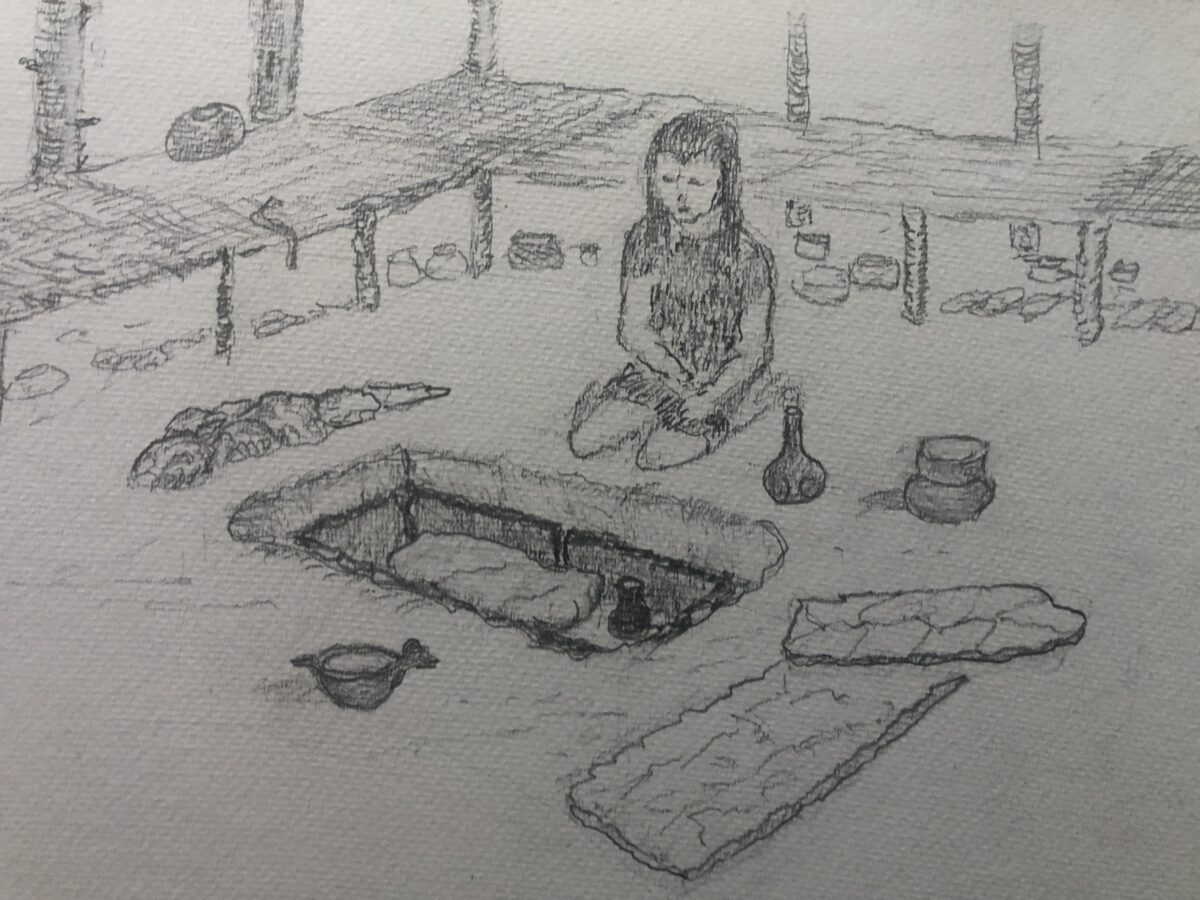
Cultural Context of Ancient Historical Periods and Phases (2)
The available research suggests that the Old Town site was occupied primarily during the Thruston phase (AD 1250–1450) of the Middle Cumberland Mississippian period, although undocumented early and later occupation are possible.
Mississippian Period (AD 900-1500)
Mississippian culture in the area was largely a continuation of Woodland period traditions, but with more distinctive subsistence and settlement changes, including permanent, settled agricultural communities. Large villages were usually fortified with palisades and sites were typically located on small hilltops overlooking broad floodplain farmland.
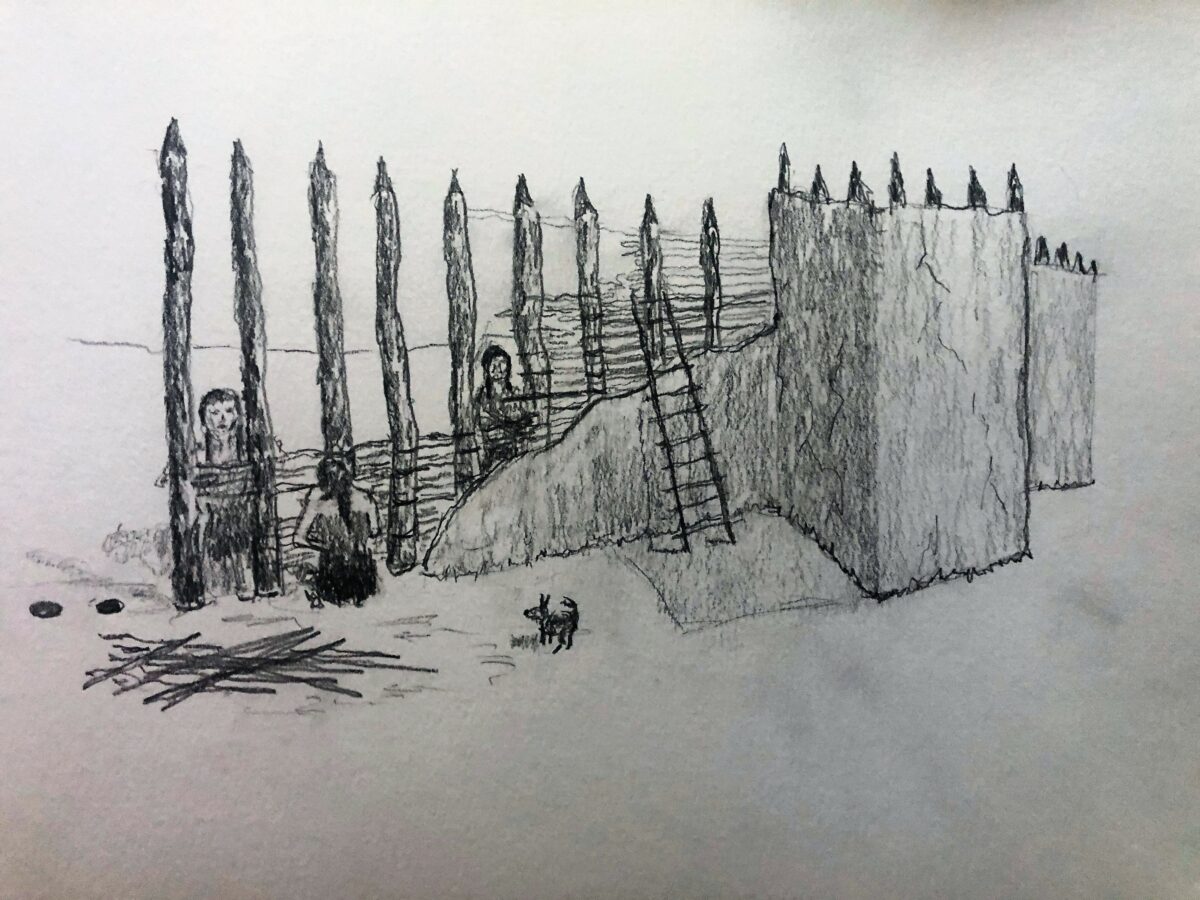
These villages were associated with smaller hamlets (Peebles 1978). Farming contributed most of the diet, with corn (Zea mays), beans (Phaseolus vulgaris), and squash (Cucurbitis sp.) forming the basis for subsistence (Lewis 1996:127). The bow and arrow were still in use for hunting, raiding, and warfare. Politically, society was organized around chiefdoms (Fried 1967:7). Hierarchical social organization based on ascribed status may have become the norm, as evidenced by the large size of some communities (such as Cahokia in Illinois and Moundville in Alabama) and the presence of large, flat-topped mounds used as platforms for elite residences. Material culture was marked by a widescale exchange of intra- and extra-regional prestige goods, including exotic shells, copper, and chert hoes made from Dover, Mill Creek, and Kaolin cherts. The primary diagnostic artifacts of the Mississippian are a wide variety of utilitarian and non-utilitarian shell-tempered ceramics, small triangular projectile points, and rectangular wall-trench houses.
The local, regional expression of Mississippian culture in north-central Tennessee is known as the Middle Cumberland Culture (Smith 1992), the most distinguishing aspect of which, aside from regionally distinct ceramic assemblages, is the famous “stone-box grave” method of interment. Although the Middle Cumberland Culture is frequently identified by stone-box graves, this obscures the complexity of the period’s archaeological record. Smith (1992) and Smith and Moore (1996) developed and refined a regional chronology for Middle Cumberland Mississippian that includes several distinct phases. More important, they developed a model of social and political change correlating with these phase-level constructs. This model postulates regional fluctuations in the degree of differentiation between status ranks and in the degree of centralized political power. It also postulated an early or emergent interval called the Spencer phase (AD 950–1050). Following that is the Dowd phase (AD 1050–1250), a period of increased political centralization and differentiation between ascribed status ranks. This phase is followed by the Thruston phase (AD 1250–1450), a later trend toward community-level political autonomy, intercommunity confederacies, and community-level decision-making hierarchies based on achieved rather than ascribed status.
Smith and Moore (1996) further postulated that Middle Cumberland society continued a trend toward increased social and political segmentation that culminated in the virtual abandonment of the region around AD 1300. Evidence for their model is predicated primarily upon settlement pattern data but also upon their interpretation of the dating of political centers and the distribution of presumed status markers in the archaeological record. The existing archaeological record for Middle Cumberland Mississippian is extensive but far from complete. It is therefore open to alternative interpretations of the complex political and social changes during this period.
Significant Mound Sites of Middle Tennessee
The Nashville area is estimated to have contained close to thirty mound sites. Some of these sites are still unchronicled, though many served as the subject of study over the course of the past centuries. The accompanying map shows the locations of certain significant mound sites, while also providing a brief description of the details pertaining to each site.
Click the map below to explore
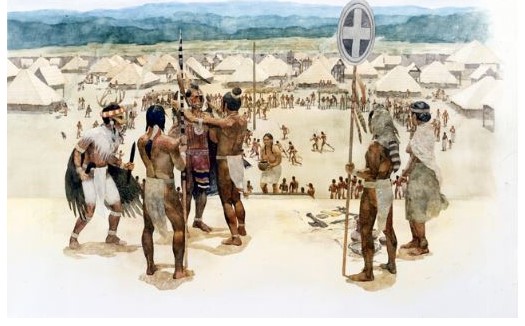
Spencer Phase (AD 950–1050)
The Spencer phase, proposed by Moore et al. (1993), is indicative of Emergent or Early Mississippian in the Middle Cumberland area. It appears to be a local development and is the least understood of the three proposed Mississippian phases for this area (Moore and Smith 1993). The phase, tentatively defined based on the excavations at the small multicomponent Spencer site (40DV191), was proposed to span the transition from the low-density, relatively mobile Late Woodland populations to the more nucleated Mississippian populations in the Middle Cumberland area (Walling et al. 2000; Moore et al. 1993; Smith 1992).
The introduction of new varieties of maize from the confluences of the Tennessee, Cumberland, and Ohio rivers during this time may have helped to bring about the rapid expansion in the growth of Mississippian cultures along the lower and middle Cumberland River. More productive and stable varieties of maize coming into the region could have led to a more sedentary lifestyle, population nucleation, and the establishment of more specialized community structures as focal points for the local populations (Walling et al. 2000; Smith 1992). Stone-box burials and artifact types interpreted as indications of elite social status do not appear associated with this phase (Moore et al. 1993). Ceramics during the Spencer phase were typically coarse shell-tempered and mixed shell and clay, or shell-and-grit-tempered. Bell Plain and Bell smoothed are also observed, but they do not appear to be a significant part of Spencer phase ceramic assemblages. It appears that cord marking and smoothed-over cord marking were the only significant surface embellishments, and effigy forms were absent during this phase (Walling et al. 2000; Smith 1992). Ceramic vessel forms consisted of the more mundane or utilitarian types. The forms represented at the Spencer site were restricted to globular and subglobular jars, blank-faced hooded bottles, fabric-impressed pans, and cylindrical-necked bottles, in order of decreasing frequency within the collection. Bowls, plates, and beakers are not found within Spencer site collections. Bowls occurred in later local assemblages, while plates and beakers are not commonly encountered in the central Cumberland area (Moore et al. 1993). Handles were rare and primarily consisted of lugs, a common form in later Mississippian assemblages. Loop handles that occur on Spencer sites are riveted and unadorned.
Lithic artifact assemblages are composed of the now-common small triangular points (Madison) and a variety of tools and artifacts similar to the Late Woodland forms, primarily made from local cherts such as Dover.
A limited number of recorded sites are known to contain Spencer phase components. The large Mississippian center of Mound Bottom/Pack (40CH8/40CH1), located in Cheatham County along the Harpeth River, is thought to have a Spencer component (Moore et al. 1993; O’Brien 1977; Smith 1992). Additionally, Moore and Smith (1993) suggested that Hamilton points recovered in large numbers at the Mound Bottom site might be associated with the Spencer phase (O’Brien 1977; Smith 1992). Hamilton points are thought of as Late Woodland temporal markers. Several other sites identified as having Spencer phase components, including 40DV297 and Lock 3 (40SU112) (Moore et al. 1993). Limited testing was conducted at 40DV297, and two extended pit burials were identified, reinforcing that the stone-box burial is a post–Spencer phase innovation. The Lock 3 site is only known from limited surface collections, but it appears to be another small Spencer locale (Moore et al. 1993). Small hamlets may represent the primary settlement type for the Spencer phase and the subsequent Dowd phase (Smith 1992).
Dowd Phase (AD 1050–1250)
During the Dowd phase, numerous small autonomous and semi-autonomous polities along the Cumberland River developed. Dowd phase settlements consisted of small centralized villages, each with a single platform mound. The populations grew rapidly at these centralized villages, which expanded outward and dispersed into the countryside. New single-family farmsteads were formed, 12 which in turn grew into hamlets and small villages, thereby repeating the process. The end of the Dowd phase was marked by systemic sociopolitical collapse when the expansion of population and settlement systems resulted in increased competition and conflict. This was reflected in the growth of nucleated fortified villages during the subsequent Thruston phase (AD 1250–1450; Moore and Smith 1993).
The Dowd phase is most significantly characterized by the stone-box burial regime. Stone-boxes used for burial first appeared around AD 1100 and rapidly became widespread. The orientation of stone-box burials varies, but the construction of graves is fairly standardized: thin slabs of stone (usually limestone) form a lining for the grave shaft; the majority of excavated examples contain two large vertical slabs along each side and one more at either end. Two or three slabs were then placed horizontally on top of the vertical slabs to form a cap. Slabs were not usually placed on the bottom, beneath the buried individual (Dowd 1972; Smith 1992; Dowd 2008).
Changes in subsistence, structures, ceramics, and lithics also characterize the Dowd phase. Subsistence during this time relied more on increases in maize production, which resulted from the introduction of new varieties. Structures were generally square with rounded corners, interior support posts, a central prepared hearth, and other assorted features (Moore and Smith 1993). The wall-trench structures commonly encountered on contemporary Mississippian sites had not yet been adopted during the Dowd phase. Ceramics during the Dowd phase consisted primarily of fine, shell-tempered plain wares, with lesser amounts of coarse shell-tempered and mixed shell/grit-tempered plain ceramics. The most common surface treatment was plain; however, additional surface treatments included cord-marked, fabric-impressed (on salt pans), incised (Matthews Incised), and painted. Jars were the predominant vessel form, with pans (fabricimpressed and plain), bottles, and bowls, in decreasing order of frequency, also represented. Additionally, outward-sloping bowl forms occurred early in the phase (Smith 1992). Lithic assemblages from Dowd phase sites do not differ significantly from those of the preceding Spencer phase. Artifacts appear to have been made predominately from locally derived St. Louis cherts, with Dover chert and greenstone the only non-local lithic materials in the assemblages. Projectile points consisted of the familiar small triangular types (i.e. Madison).
Dowd phase sites are better documented than the Spencer phase sites in the middle Cumberland River drainage. However, the later Thruston phase sites are the best documented. Most of the identified examples are found in the Nashville Basin. Excavation at these sites has usually consisted of salvage operations or burial removal. Several sites that were reported to have significant Dowd phase components are Brandywine Point site (40DV247), Brick Church Business Park site (40DV301), and the French Lick site (40DV5).
Thruston Phase (AD 1250–1450)
The Thruston phase exemplifies and represents the climax of Mississippian culture in the Middle Cumberland region of Tennessee. Smith (1992) proposed and defined the Thruston phase as the final response to the growing political and environmental stress resulting from the developing Mississippian pattern within which they operated.
The Thruston phase is distinguishable from the Spencer and Dowd phases through its settlement patterns, construction, and material culture. First, settlement patterns changed: the hamlets and farmsteads of the previous phase were abandoned, and palisaded villages became the dominant settlement pattern throughout the Nashville Basin. Mound construction ceased, and existing substructure mounds were converted for use as cemeteries. The construction of wall-trench houses became more prevalent, and the “stone-box grave” internment continued.
Material culture also saw distinct changes. Mississippian Plain dominated ceramics, followed in frequency by Bell Plain, and less frequently Kimmswick Fabric Impressed and Plain types. Decorated wares, incised and/or punctated, appear to make up only a miniscule portion of any Thruston phase ceramic assembly. These decorated types, primarily known from their mortuary contexts, consist of Mathews Incised, often with zoomorphic/anthropomorphic strap handles, and negatively painted wares. Red-slipped and cord-marked surface treatments are absent in Thruston phase assemblages (Smith 1992). Vessel forms were predominately globular or subglobular jars, often with loop, strap, or lug handles. Jars are the only forms reproduced as miniature vessels (Walling et al. 2000). The Thruston phase marks the initial appearance of carafe-necked bottles, full-figured effigy bottles (see image drawings and pictures below), simple hemispherical bowls with notched horizontal appliqué strips, anthropomorphic and zoomorphic effigies, and strap handles. Fish, bird, and beaver effigies on restricted or incurvate rim bowls are also characteristic of the Thruston phase (Smith 1992). Expressive ceramic items, such as pottery “trowels,” ceramic disks, and earplugs are associated with this phase.
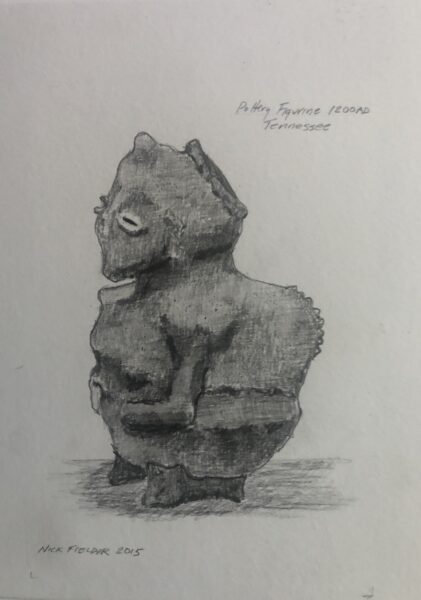
Thruston phase lithic assemblages include small triangular, serrated points (Sand Mountain) and varieties of chipped and ground-stone artifacts (Moore and Smith 1993; Smith 1992). Chipped bifacial eccentric or “ceremonial” artifacts made from Dover chert are encountered in the assemblages, including mace, sword, and claw forms. Other chipped and ground stone artifacts seen are hoes, often of Dover or Mill Creek chert, celts, discoidals, and a variety of more utilitarian items. In addition to the previously mentioned Dover and Mill Creek cherts, other nonlocal materials include greenstone, copper, galena, mica, and ocher (Smith 1992).
Women were the potters in the village. They used traditional shapes and decorative techniques that changed over time, thus allowing archaeologists to estimate when they were made. Above drawings by Nick Fielder, 2022.
A large variety of worked shell and bone artifacts, including shell spoons, cups, beads and gorgets, are known from Thruston phase components. Many of the gorgets are plain and, like other shell and bone artifacts in Thruston assemblages, typically found in a domestic context. Other more ornamental types, such as the scalloped triskele gorget termed by Thruston (1973) and Muller (1966), are commonly associated with Thruston phase mortuary practices (Smith 1992).
Distribution of Thruston phase sites appears to center in the Nashville Basin along the Cumberland and Upper Harpeth rivers. This range extends down the Cumberland River, as far west as Western Highland Rim, and eastward as far as the Caney Fork River.
Within the region, a number of sites have been identified which contain or have components attributed to Thruston phase occupations. Some of the significant ones are East Nashville Mounds site (40DV4) (Walling et al. 2000), Castalian Springs (40SU14) (Smith 2003), the Fewkes site (40WM1) (Dicks 1999), Kelley’s Battery site (40DV392), Mound Bottom/Pack (40CH8/40CH1) (O’Brien 1977; Smith 1992), Gordontown (40DV6), and West (40DV12) (Dowd 1972). Based on the limited information available on Old Town (40WM2), it is thought to primarily have been occupied during the Thruston Phase (Smith 1993).
(1) Tennessee’s Native American History: From Removal to Present Day in Tennessee, Savannah Roth, https://arcg.is/1OT5Gb0, June 15, 2020.
(2) Geophysical Survey of Old Town Archaeological Site (40WM2) Williamson County, Tennessee by New South Associates, Inc., Sarah Lowry (Principal Investigator), September 20, 2019.
Other Similar Mississippian Sites
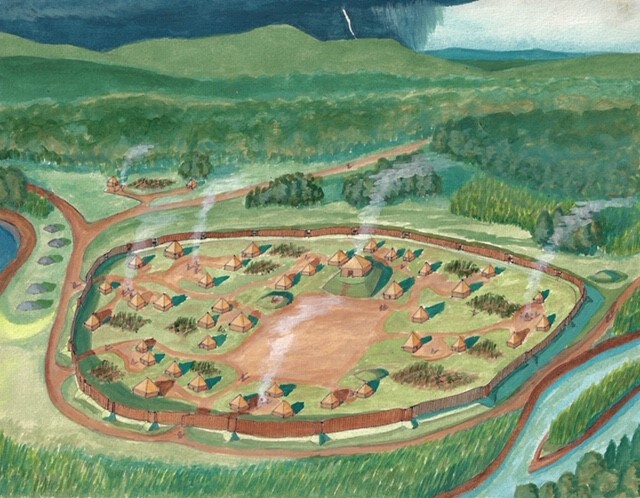
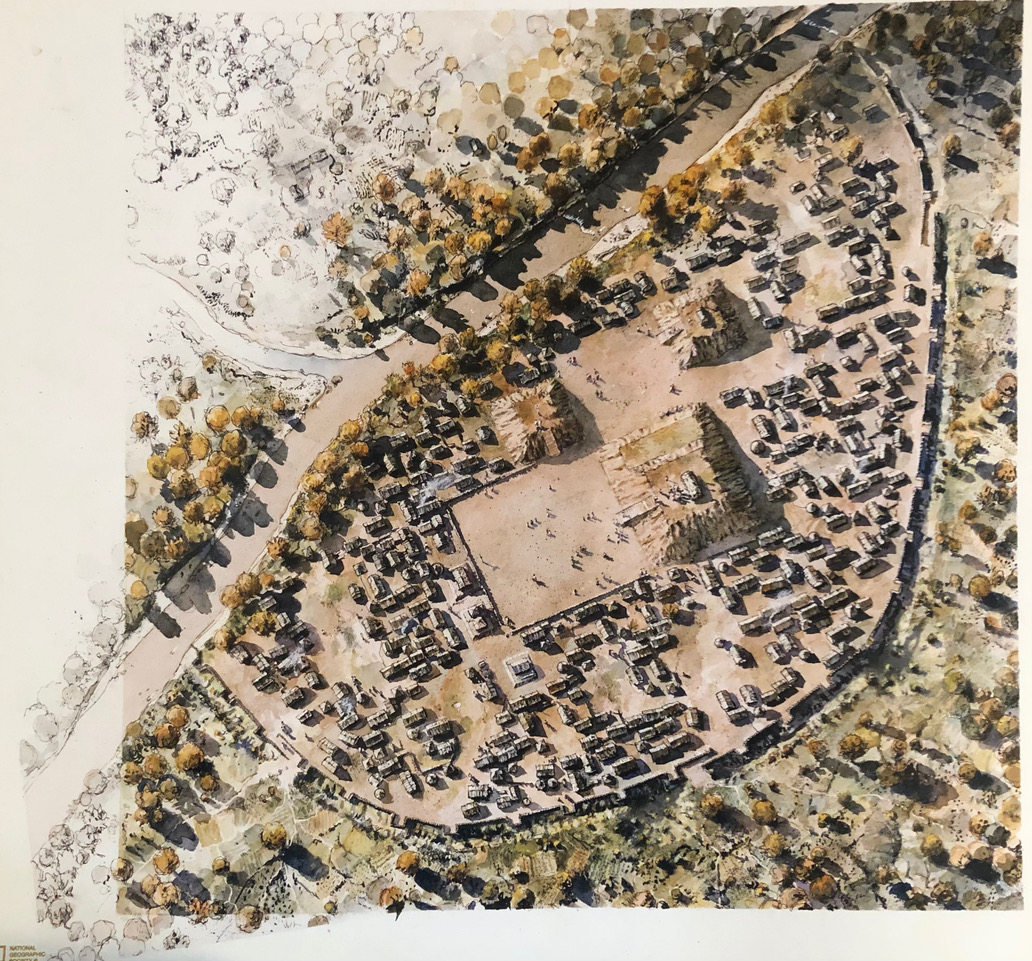
Top: Sellers Indian Mound in Wilson County, TN,
Bottom: Etowah in North Georgia

